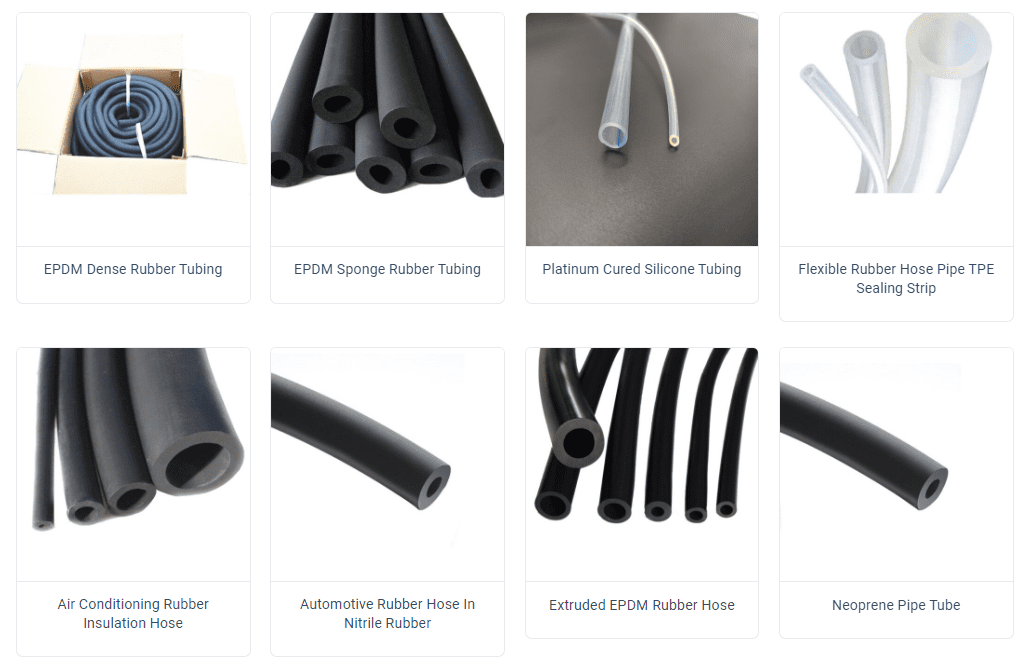Rubber tubing is an essential component in many industrial and commercial applications. From automotive fuel lines to medical equipment and chemical transport systems, rubber tubes offer flexibility, durability, and resistance to heat, pressure, and chemicals.
What is Rubber Tubing?
Rubber tubing refers to hollow, flexible tubes made from natural or synthetic rubber. It is widely used to carry fluids or gases, insulate wires, or dampen vibrations in dynamic systems.
Key Characteristics:
- Elasticity & Flexibility: Ideal for dynamic environments.
- Durability: Withstands high pressure, extreme temperatures, and harsh environments.
- Chemical Resistance: Suitable for chemical transfer in industrial applications.
- Temperature Resistance: Common range is -40 °F to 248 °F (-40 °C to 120 °C).
- Electrical Insulation: Helps insulate cables and electrical components.
- Vibration Damping: Reduces shocks and mechanical vibrations.
Common Applications of Rubber Tubing
Rubber tubing is used across various industries. Here are key examples:
- Automotive: Fuel hoses, brake systems, air ducts
- Medical: IV lines, anesthesia delivery, lab equipment
- Industrial: Chemical transfer, compressed air lines, water handling
- Electrical: Wire insulation, conduit protection
- Food & Beverage: Safe liquid dispensing and handling
- Pharmaceutical: Sanitary fluid transport
- HVAC Systems: Air and water circulation tubes
- Marine & Aerospace: Fluid management and vibration isolation
- Agriculture: Irrigation and chemical spraying systems
Types of Rubber Tubing
Understanding the right type of rubber tubing is essential for selecting the best solution for your application. Based on material composition and structure, rubber tubing is generally classified into the following three types:

1. Natural Rubber Tubing
Made from natural latex, this type offers excellent elasticity and is ideal for low-to-moderate pressure applications.
Advantages:
- High flexibility and resilience
- Cost-effective
- Biodegradable
Limitations:
- Poor resistance to oil and UV exposure
- Not suitable for high-temperature chemicals
2. Synthetic Rubber Tubing
This category includes materials like EPDM, Neoprene, Silicone, and NBR, offering excellent chemical and thermal resistance.
Advantages:
- Customizable material properties
- Excellent resistance to oil, heat, ozone, and UV
- Long service life
Limitations:
- Slightly less flexible than natural rubber
- Higher cost for premium materials
3. Reinforced Rubber Tubing
Constructed with textile or metal reinforcements, these tubes are designed for high-pressure or demanding environments.
Advantages:
- Superior strength and burst resistance
- Suitable for hydraulic and fuel systems
- Stable in fluctuating pressure conditions
Limitations:
- Less flexible and heavier
- Higher manufacturing complexity
Quick Comparison Table
| Type | Flexibility | Temp Resistance | Chemical Resistance | Best For |
| Natural Rubber | ★★★★★ | ★★★ | ★★ | Medical, light-duty use |
| Synthetic Rubber | ★★★★ | ★★★★★ | ★★★★★ | Automotive, industrial |
| Reinforced Rubber | ★★ | ★★★★ | ★★★★ | High-pressure systems |
How to Choose the Right Rubber Tubing?
Choosing the right tubing depends on several factors:
1. Application Environment
- What is the working temperature and pressure?
- Will the tubing come into contact with oils, acids, or solvents?
- Is UV or ozone resistance required?
2. Material Requirements
- Does it need to be food-grade, flame-retardant, or conductive?
- Is high flexibility or resilience a priority?
3. Size & Construction
- Inner/outer diameter, wall thickness, and reinforcement needs
4. Regulatory Compliance
- Does the tubing need to meet standards like FDA, RoHS, or REACH?
When in doubt, consulting with rubber product specialists is the best way to ensure a perfect match for your needs.
Final Thoughts
Rubber tubing is a versatile, high-performance solution across industries. Whether you’re working in the automotive sector, food processing, or industrial manufacturing, selecting the right natural, synthetic, or reinforced rubber tubing can ensure reliability, safety, and longevity.
Need expert guidance on custom rubber tubing solutions? 📧 Contact us!
